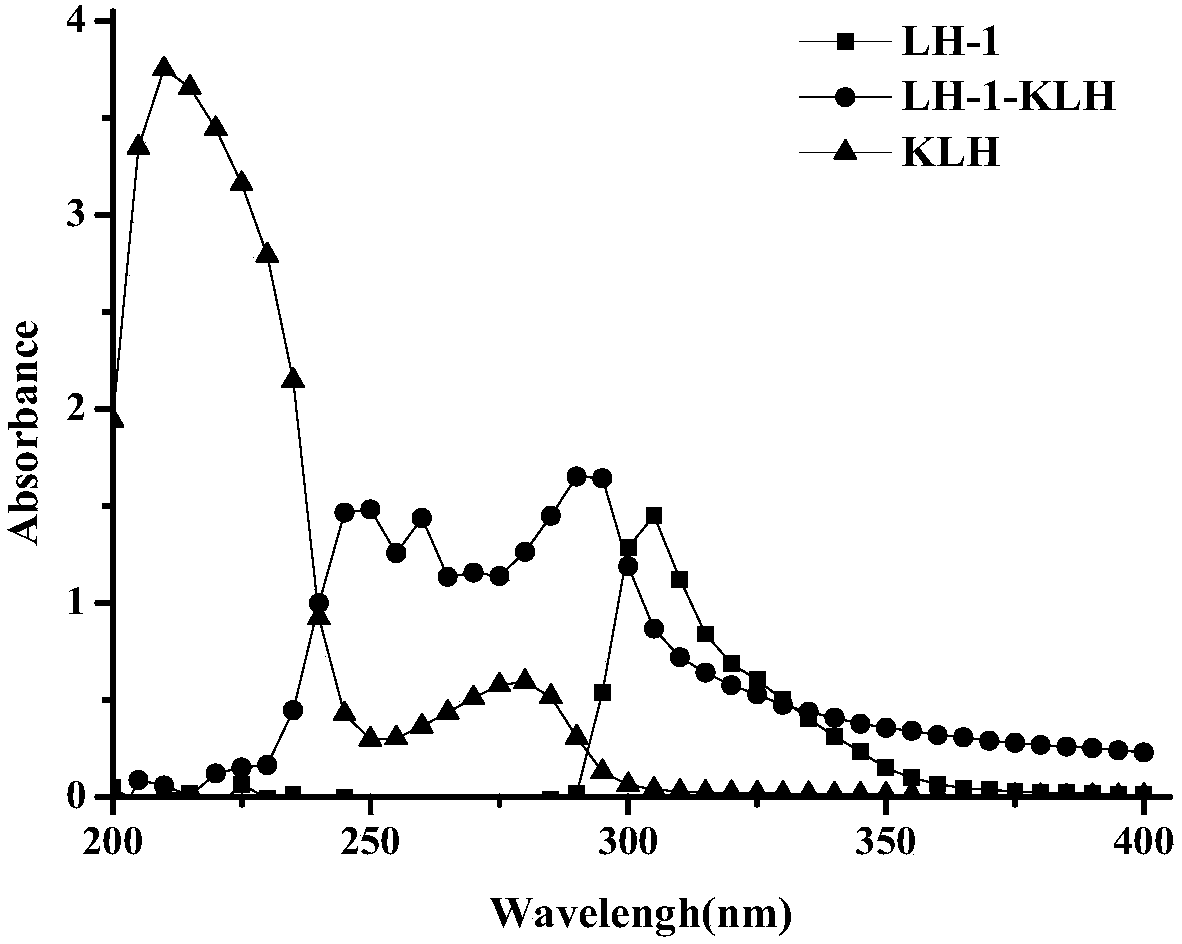A novel small molecule structure and its application in the detection of blue-green algae hepatotoxins
A blue-green algae liver and small molecule technology, applied in measurement devices, analytical materials, instruments, etc., can solve problems such as differences in antibody characteristics and broad-spectrum limitations, and achieve high sensitivity, broad-spectrum, and easy operation. Effect
- Summary
- Abstract
- Description
- Claims
- Application Information
AI Technical Summary
Problems solved by technology
Method used
Image
Examples
Embodiment 1
[0059] Example 1 Synthesis of novel small molecule LH-1 structure
[0060] 1. Synthesis of new small molecule structure LH-1
[0061] The synthetic route of the novel small molecule structure LH-1 is as follows: figure 2 As shown, the specific reaction process is as follows:
[0062] (a) Aldol condensation of biuret: At room temperature, weigh 26.2g of D-propionylthioazoalkylthione (CAS: 1217320-19-8) and dissolve it in 250mL of anhydrous dichloromethane, then stir in Cool in acetone with dry ice to -78°C, add 12 mL of titanium tetrachloride dropwise to the above solution, stir the resulting mixture for 15 min to form a titanium complex, then add 18.9 mL of distilled N,N-diiso Propylethylamine, the mixture was then stirred for 40 min to form the corresponding titanium enolate, then 20.0 mL of freshly distilled N-methylpyrrolidone was added, and after 10 min, 13.4 mL of freshly distilled phenylacetaldehyde was added, and the above solution was continued at -78 ℃ for another...
Embodiment 2
[0081] Example 2 Synthesis of artificial antigen
[0082] 1. Synthesis of artificial antigen
[0083] (1) Accurately weigh 2 mg of LH-1, 1 mg of NHS and 1 mg of EDC, dissolve in 500 μL of DMF, and stir overnight in the dark at room temperature, no precipitation appears;
[0084] (2) 8 mg of keyhole limpet hemocyanin (KLH) was added to 500 μL of carbonic acid buffer (0.1moL / L, pH 9.6);
[0085] (3) Slowly add the LH-1 solution dropwise into the KLH solution, and stir for 3 hours at room temperature in the dark;
[0086] (4) Dialyze with phosphate buffer saline for two days, 4 times a day, and obtain LH-1 artificial antigen after dialysis.
[0087] (5) The coupling method of MC-LR and ovalbumin (OVA) is the same as above.
[0088] Carbonate solution (0.1M, pH 9.6): weigh 1.59g Na 2 CO 3 and 2.93g NaHCO 3 , Dilute to 1000mL with deionized water.
[0089] Phosphate buffer (0.01M, pH 7.4): Na 2 HPO 4 12H 2 O 2.90g, NaCl 8.50g, KCl 0.20g, KH 2 PO 4 0.20g, add deionized ...
Embodiment 3
[0093] Example 3 Preparation and Purification of LH-1 Polyclonal Antibody with New Small Molecule Structure
[0094] 1. Preparation of novel small molecular structure LH-1 antibody
[0095] New Zealand white rabbits were immunized with LH-1-KLH, 1mg / mL artificial antigen solution was mixed and emulsified with an equal amount of adjuvant, the initial immunization was mixed with Freund's complete adjuvant after emulsification, and the immunogen and Freund's complete adjuvant were mixed and emulsified for the subsequent booster immunization. After emulsification of incomplete adjuvant, the animals were immunized four times, with an interval of 3 weeks between each time.
[0096] 2. Purification of LH-1 polyclonal antibody with new small molecule structure (caprylic acid-ammonium sulfate method):
[0097] (1) Take rabbit serum and centrifuge at 12000r / min for 15min at 4°C to remove the precipitate;
[0098] (2) Mix 1 volume of rabbit serum with 2 volumes of acetate buffer (pH 4....
PUM
 Login to View More
Login to View More Abstract
Description
Claims
Application Information
 Login to View More
Login to View More - R&D
- Intellectual Property
- Life Sciences
- Materials
- Tech Scout
- Unparalleled Data Quality
- Higher Quality Content
- 60% Fewer Hallucinations
Browse by: Latest US Patents, China's latest patents, Technical Efficacy Thesaurus, Application Domain, Technology Topic, Popular Technical Reports.
© 2025 PatSnap. All rights reserved.Legal|Privacy policy|Modern Slavery Act Transparency Statement|Sitemap|About US| Contact US: help@patsnap.com



